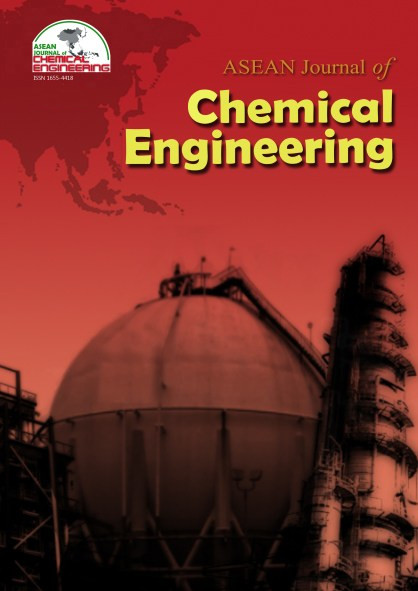Use of Electrochemical Peroxidation to Degrade Reactive Blue 19: Application of a 23 Full Factorial Design
Abstract
A 5000 g/m3 CI Reactive Blue 19 dye solution was treated using electrochemical peroxidation (ECP) process. This method involves the utilization of Fenton’s reaction chemistry through the addition of hydrogen peroxide into the solution and the use of an iron anode as source of Fe(II) catalyst. The degradation of the dye was evaluated using a 23 full factorial design augmented with four centerpoints. The factors and levels of the experimental design were as follows: initial pH (2.2, 2.5, 2.8), initial H2O2 dosage (332 mol/m3, 377 mol/m3, 422 mol/m3), and current density (164 A/m2, 205 A/m2, 246 A/m2). Results of the study showed that initial pH-current density interaction significantly influenced the percent COD removal. Moreover, after 60 minutes of treatment, the percent absorbance reduction reached up to 99.98% and the percent COD removal reached up to 82.83%.
References
2. Brillas, E., I. Sires, et al. (2009). "Electro-Fenton Process and Related Electrochemical Technologies Based on Fenton's Reaction Chemistry," Chem Rev, 109(12), 6570-6631.
3. Fu, Y. and T. Viraraghavan (2001). "Fungal decolorization of dye wastewaters: a review," Bioresour Technol, 79(3), 251-62.
4. Kim, T.-H., Y. Lee, et al. (2004). "Decolorization of dye solutions by a membrane bioreactor (MBR) using white-rot fungi," Desalination, 168, 287-93.
5. Kobya, M., O. T. Can, et al. (2003). "Treatment of textile wastewaters by electrocoagulation using iron and aluminum electrodes," Journal of Hazardous Materials, B 100, 163-178.
6. Lorimer, J. P. (2001). "Degradation of dye effluent," Pure Appl. Chem., 73(12), 1957-1968.
7. Martinez-Huitle, C. a. E. B. (2008). "Decontamination of wastewaters containing synthetic organic dyes by electrochemical methods: A general review," Applied Catalysis B: Environmental, 87(3-4), 105-145.
8. Modirshahla, N., M. A. Behnajady, et al. (2007). "Investigation of the effect of different electrode connections on the removal efficiency of Tartrazine from aqueous solutions by electrocoagulation," Dyes and Pigments, 74, 249-257.
9. Parac-Osterman, D., V. Durasevic, et al. (2007). "Comparison of Chemical and Physical-chemical Wastewater Discoloring Methods," Kem. Ind., 56(11), 543-549.
10. Pelegrini, R., P. Peralta-Zamora, et al. (1999). "Electrochemically assisted photocatalytic degradation of reactive dyes," Applied Catalysis B: Environmental, 22, 83-90.
11. Rezaee, A., M. T. Ghaneian, et al. (2008). "Decolorization of Reactive Blue 19 Dye from Textile Wastewater by the UV/H2O2 Process," Journal of Applied Sciences, 8(6), 1109-1112.
12. Slokar, Y. M. and A. M. L. Marechal (1998). "Methods of Decoloration of Textile Wastewaters," Dyes and Pigments, 37(4), 335-356.
13. Tauber, M. M., G. M. Guebitz, et al. (2005). "Degradation of azo dyes by laccase and ultrasound treatment," Appl Environ Microbiol, 71(5), 2600-7.
14. US EPA (1996). Best Management Practices for Pollution Prevention in the Textile Industry, U.S. Environmental Protection Agency, Cincinnati, Ohio.
15. US EPA (1997). EPA Office of Compliance Sector Notebook Project: Profile of the Textile Industry, US Environmental Protection Agency, USA.
16. Vlyssides, A. G., D. Papaioannou, et al. (2000). "Testing an electrochemical method for treatment of textile dye wastewater," Waste Management, 20, 569-574.
17. Zollinger, H. (1991). Color chemistry: syntheses, properties and applications of organic dyes and pigments, VCH Publishing, Weinheim.
Copyright holder for articles is ASEAN Journal of Chemical Engineering. Articles published in ASEAN J. Chem. Eng. are distributed under a Creative Commons Attribution-NonCommercial 4.0 International (CC BY-NC 4.0) license.
Authors agree to transfer all copyright rights in and to the above work to the ASEAN Journal of Chemical Engineering Editorial Board so that the Editorial Board shall have the right to publish the work for non-profit use in any media or form. In return, authors retain: (1) all proprietary rights other than copyright; (2) re-use of all or part of the above paper in their other work; (3) right to reproduce or authorize others to reproduce the above paper for authors’ personal use or for company use if the source and the journal copyright notice is indicated, and if the reproduction is not made for the purpose of sale.



